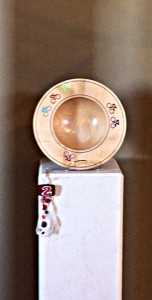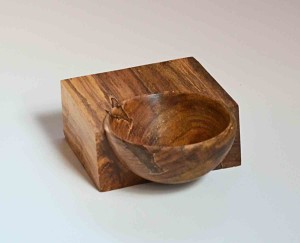
Dennis has been to see the Bike Art Show here in the Pikes Peak Region for at least five years. This year, he made a bowl to commemorate the 7-Eleven Velodrome in Colorado Springs. It is a clean hard maple with inlaid crushed stone in the shape of bicycle racers.
This may be the first bowl ever in the Bike Art Show. It follows a long tradition of decorating bowls with arena events. Picasso painted the bull fight arena on ceramic bowls fifty years ago, and now we have Dennis Liggett and bicycle track racing.
A highlight of this year’s show wasn’t an entry–it was an ice cream maker churned via stationary bicycle.
 This little bowl of ambrosia maple is struggling to emerge from its block of wood.
This little bowl of ambrosia maple is struggling to emerge from its block of wood.
The woodturner also faces some challenges turning this piece! Like the Roman Canteen, the Emerging Bowl requires turning on two different axes. Dennis has chosen this project as a companion to the canteen for the intermediate woodturner. It is well within the range of most intermediates, but it has a more advanced ‘wow’ factor.
Like the Roman Canteen, the emerging bowl requires careful planning. It also introduces some extra safety considerations. Surprisingly, turning two of them is only a little more difficult than turning one.
Most of the things that Dennis makes have roots in traditional woodturning. This one goes back to the way Hans Weissflog developed many of his forms in Germany, and has also been popular with turners in Canada and Australia.
September 2, 2012 – 4:03 pm
Dennis has been working in the shop to produce over 65 bowls for the October 10th Empty Bowl fundraiser for Tri-Lakes Cares. The bowl blanks were donated by Dr. Bob Gibbs, fellow woodturner and volunteer physician for Tri-Lakes Cares.
The small bowl in the photo is from apple wood. The little leaf inside was burned by Kay, who added decoration to some of the smallest bowls. Other bowls feature some of the decorating techniques the Liggetts learned from Nick Agar during his visit in May.

October 15, 2011 – 9:34 am
Bigger bowls come from large trees with solid wood. Dennis picked up sections of a big hard maple from Missouri two years ago. He rough-turned the bowls and let them dry two years. The finish turned bowls have uniform wall thicknesses. The inlaid bands are turquoise, malachite, lapis, and pipestone.
How simple the form, and how varied the shape! One of these captures and holds its contents, and the other opens out to the dome of the sky. They are 15-17″ in diameter:


December 17, 2009 – 7:57 pm
Some folks have inquired about purchasing one of the natural edge bowls. Dennis makes them in batches from freshly-cut trees, so the inventory of bowls depends upon the availability of good trees. For this winter, bowls from cherry and ash are for sale in the M.A. Doran Gallery in Tulsa, OK, during the Holiday Sale which runs through January 2nd.
Dennis will look for new trees during January in order to produce another batch of bowls with bark. Generally, he is able to find cherry or ash in northwest Missouri, which has more hardwood trees than Colorado. The winter-cut trees hold the bark better. This is one of those works of art that takes both art and science! When you see a natural edge bowl that you like, get it, because the grainlines will probably never be repeated in a subsequent bowl. These are unique collaborations between the woodturner and Mother Nature.
Caring for a natural edge bowl: It’s best to keep it out of direct sunlight, which will darken the wood. Choose only light-weight, non-liquid contents! If the surface needs polishing, use a high-quality paste wax, applied very thinly and delicately rubbed out. The original finish was ‘Renaissance Wax.’ Contact Dennis if you have questions about caring for any of your woodturnings.
April 17, 2009 – 10:03 pm
Working with green wood has been a new adventure for Dennis. He turns these natural edge vessels down to less than 1/16th thickness in the first session on the lathe, and then refines them in the final session. The thin walls ovalize as they dry, but the bark stays on most of the time. Dennis started out with Richard Raffan’s advice to avoid turning feet on the vessels:

Deep Ash Vessel 8" x 8" dia
Natural edge vessels are fascinating because they are often turned sidegrain. This means that the vessel’s vertical dimension is perpendicular to the trunk. (Picture the curve of the rim as a circle wrapped around the trunk of the tree.) As the wood dries, it moves into a more ovalized shape along the vertical dimension of the fibers.
The appeal of the form is evident in the way that the lighter sapwood emphasizes the shape, drawing attention to the graceful curves of the grain. This one is restrained –almost in-curving at the rim. It sits quite securely on the base, which allows just enough shadow underneath to lift it slightly off the table.
Dennis turned the deep ash vessel from a freshly cut ash log in January 2009.

Small ash vessel 4" x 4" dia
This much smaller vessel, pictured at closer range, has a very rounded base, which made the vase ‘weeble’ back to the upright position when it was tipped to the side. The good sense of balance of this piece is evident when you hold it in your hand.
Dennis began turning feet on his vessels in ash and cherry in December and January of 2009. He went through a whole cherry tree exploring the challenge of fitting the correct foot to the vase. This one captures something of the gesture of outstretched arms. Cover the foot, and you lose that sense of lift.

Adding a small foot to the form







